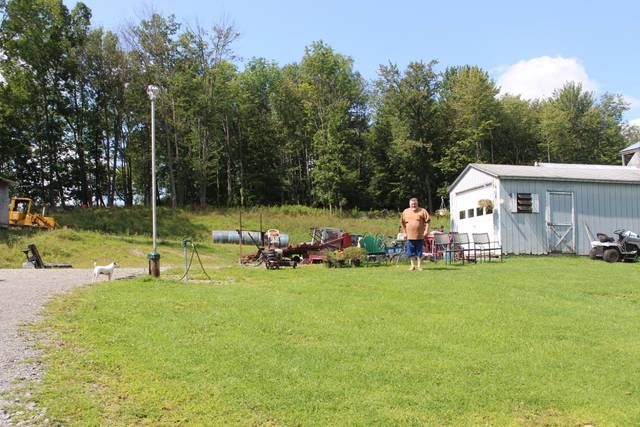Click here to subscribe today or Login.
DIMOCK, Pa. (AP) — The well water at Ken Morcom and Kim Grosso’s house is laced with so much explosive methane that a Pennsylvania environmental regulator who went there to collect samples this summer decided it would be safer to coast her SUV down the driveway.
Morcom and Grosso want to leave but doubt they could sell a house with tainted water. So, a few weeks ago, they asked the gas driller they blame for polluting their well to buy them out.
“I was hoping they’d fix it. But I’ve given up hope,” said Morcom, 49, who supports drilling but has become disillusioned with Houston-based Cabot Oil & Gas Corp. “Just let us out of the box.”
“The box” is the couple’s 8-acre spread in rural Dimock Township. But Morcom could have been talking about Dimock itself.
A patchwork of homes and farms about 150 miles north of Philadelphia, the community became a battleground for pro- and anti-drilling forces after state regulators found that Cabot — one of the biggest drillers in the vast Marcellus Shale gas field — had contaminated 18 residential wells with methane. Homeowners sued, accusing the company of polluting their water with toxic chemicals and methane. Activists and celebrities descended.
It’s a much quieter place these days. But the questions surrounding Dimock’s groundwater have yet to be resolved — and the federal government is back for the first time in more than five years to investigate ongoing claims of contamination. Public health experts visited 25 homes last month to test for bacteria, gases and chemicals.
The testing has resurrected an old debate about the groundwater in Dimock, whose plight was the focus of the Emmy Award-winning documentary “Gasland.”
State regulators say Cabot still hasn’t fixed the water. Cabot says the methane was there long before it began drilling. It’s an argument that’s been going on for eight years.
Bill Ely, whose house was tested, said his methane-laced well water looks like milk. He now pipes spring water to his house.
“My place that I’ve worked for all my life is worth nothing,” said Ely, 66.
Dimock was the highest-profile case of contamination linked to Pennsylvania’s huge gas drilling industry, but it’s far from the only one. State regulators have identified 289 cases since December 2007 in which a private water supply was affected by gas drilling, including seven so far this year.
In Dimock, the dispute centers on the extent to which methane was present in the water before Cabot showed up to drill in 2008.
The odorless, colorless gas is common in Pennsylvania groundwater. It can emanate from swamps, landfills, coal mines and gas wells. Methane is not toxic to humans, but at high concentrations it can lead to asphyxiation or cause an explosion. It was an exploding water well on New Year’s Day 2009 that first aroused public attention in Dimock.
Cabot has long insisted the gas in Dimock’s aquifer is naturally occurring, saying its pre-drill testing of thousands of private water wells in the area show a high percentage with methane. Company spokesman George Stark said he views the new testing by the U.S. Agency for Toxic Substances and Disease Registry as a waste of time and taxpayer money, pointing out that another federal agency, the Environmental Protection Agency, tested 64 homes in 2012 and concluded the well water didn’t pose a health hazard.
Critics have said the EPA buckled to industry pressure. The Agency for Toxic Substances analyzed the same data and concluded that 27 of the wells had unsafe levels of contamination. Its 2016 report drew no conclusion about whether gas drilling caused the water to become tainted.
Some residents agree with Cabot.
Lloyd Conrad, 80, said “swamp gas” has always been an issue in Dimock, including at his own house. “Bunch of yahoos,” Conrad said of residents who sued the company in 2009. “They were after this,” he added, rubbing his fingers together.
Still, Conrad wonders whether Cabot’s drilling might have made things worse. The driller pays to refill a large plastic tank on his property, called a water buffalo, that supplies Conrad’s home with water for bathing and washing clothes. Government scientists tested his well in early August.
The Department of Environmental Protection said Cabot has not yet fixed all affected water supplies, nor has it shown that all its gas wells have stopped leaking natural gas into the aquifer. As a result, the agency has refused Cabot’s requests to lift a moratorium on drilling in a 9-square-mile area of Dimock.
Though Cabot hasn’t been able to drill new wells, state regulators did permit the company to begin producing gas from six existing wells in 2012. The state agency has since held Cabot responsible for three additional cases of contamination, though Stark said two of the cases involve homeowners who have long reported gas in their water.
The third case involves Grosso and Morcom, who reported their well water went bad three months after Cabot “fracked” a nearby gas well. Fracking is a method that uses huge amounts of pressurized water, along with sand and chemicals, to extract oil and natural gas from shale.
State regulators held Cabot responsible, though they cited problems with the cementing of the gas wells and said there is no evidence that fracking itself polluted the water.
Cabot installed a third water buffalo on the couple’s property this summer, this one to water their cows.
“After five years of putting up with this,” Morcom said, “we just want out.”






